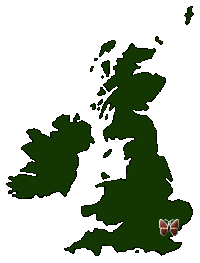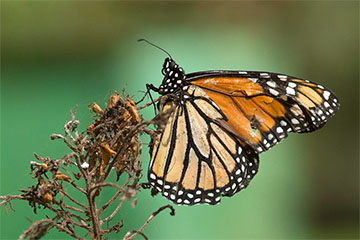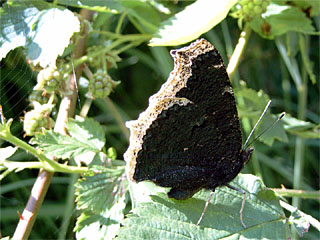The spread of  Camberwell BeautyNymphalis antiopa (Linnaeus, 1758)Mourning CloakCamberwell Beauty in
Camberwell BeautyNymphalis antiopa (Linnaeus, 1758)Mourning CloakCamberwell Beauty in  United Kingdom (Great Britain)
United Kingdom (Great Britain) United Kingdom is a special case in Europe, if not worldwide:
United Kingdom is a special case in Europe, if not worldwide:
The  Camberwell BeautyNymphalis antiopa (Linnaeus, 1758)Mourning CloakCamberwell Beauty is not native there, but can be observed there from time to time. The
Camberwell BeautyNymphalis antiopa (Linnaeus, 1758)Mourning CloakCamberwell Beauty is not native there, but can be observed there from time to time. The  Camberwell BeautyNymphalis antiopa (Linnaeus, 1758)Mourning CloakCamberwell Beauty does not reproduce in the
Camberwell BeautyNymphalis antiopa (Linnaeus, 1758)Mourning CloakCamberwell Beauty does not reproduce in the  United Kingdom (Great Britain)
United Kingdom (Great Britain) United Kingdom either, at most in very rare exceptional cases.
United Kingdom either, at most in very rare exceptional cases.
The few specimens seen, mostly in the south-east of  England
England England, are either immigrants to the continent or originate from local breeding.
England, are either immigrants to the continent or originate from local breeding.
The  Camberwell BeautyNymphalis antiopa (Linnaeus, 1758)Mourning CloakCamberwell Beauty is sporadically spotted in
Camberwell BeautyNymphalis antiopa (Linnaeus, 1758)Mourning CloakCamberwell Beauty is sporadically spotted in  Ireland
Ireland Ireland.
Ireland.
Every few decades, a large number of  Camberwell BeautyNymphalis antiopa (Linnaeus, 1758)Mourning CloakCamberwell Beauties arrive on the islands.
Camberwell BeautyNymphalis antiopa (Linnaeus, 1758)Mourning CloakCamberwell Beauties arrive on the islands.
These years are called Antiopa Years Asher, 2001 - Millennium atlas of butterflies in Britain and Ireland Chalmers-Hunt, 1977 - The 1976 Invasion of the Camberwell Beauty (Nymphalis antiopa L.) Salmon, 2000 - The Aurelian Legacy - British Butterflies And Their Collectors:
| Year | Number of find reports |
|---|---|
| 1770 | ? |
| 1789 | ? |
| 1793 | ? |
| 1820 | ? |
| 1846 | ? |
| 1872 | 436 |
| 1880 | ? |
| 1947 | 52 |
| 1976 | 270 |
| 1995 | 350 |
| 2002 | 25 |
| 2006 | 100 |
| 2007 | ? |
In 1820, a large number of dead  Camberwell BeautyNymphalis antiopa (Linnaeus, 1758)Mourning CloakCamberwell Beauties washed up on the east English coast at Durham's,
Camberwell BeautyNymphalis antiopa (Linnaeus, 1758)Mourning CloakCamberwell Beauties washed up on the east English coast at Durham's,  United Kingdom (Great Britain)Durham's (south of Newcastle upon Tyne, Northumberland,
United Kingdom (Great Britain)Durham's (south of Newcastle upon Tyne, Northumberland,  EnglandNewcastle upon Tyne). They had died while crossing the North Sea Chalmers-Hunt, 1977 - The 1976 Invasion of the Camberwell Beauty (Nymphalis antiopa L.).
EnglandNewcastle upon Tyne). They had died while crossing the North Sea Chalmers-Hunt, 1977 - The 1976 Invasion of the Camberwell Beauty (Nymphalis antiopa L.).
Legendary and unrivalled to this day is the year 1872, the so called annus mirabilis (see Distribution in United Kingdom (Invasion 1872)).
Another spectacular butterfly that also migrates to the British Isles from time to time is the  MonarchDanaus plexippus (Linnaeus, 1758)Monarch ButterflyMonarch. In 1995 and 1999 there were many sightings of the butterfly Asher, 2001 - Millennium atlas of butterflies in Britain and Ireland, which migrates from distant North America, especially in Cornwall. In 1995 there were about 200 sightings, in 1999 there were about 400 sightings.
MonarchDanaus plexippus (Linnaeus, 1758)Monarch ButterflyMonarch. In 1995 and 1999 there were many sightings of the butterfly Asher, 2001 - Millennium atlas of butterflies in Britain and Ireland, which migrates from distant North America, especially in Cornwall. In 1995 there were about 200 sightings, in 1999 there were about 400 sightings.
I was lucky enough to witness this unusual and impressive event myself in the last week of September 1999.
At that time, the  MonarchDanaus plexippus (Linnaeus, 1758)Monarch ButterflyMonarch was extremely common in New York,
MonarchDanaus plexippus (Linnaeus, 1758)Monarch ButterflyMonarch was extremely common in New York,  United StatesNew York and the surrounding area. On the east beach of Fire Island, I could see huge numbers of the large orange butterfly flying eastwards towards the open sea. At any given time, I saw at least a handful of butterflies making the long and dangerous journey across the Atlantic.
United StatesNew York and the surrounding area. On the east beach of Fire Island, I could see huge numbers of the large orange butterfly flying eastwards towards the open sea. At any given time, I saw at least a handful of butterflies making the long and dangerous journey across the Atlantic.
Some of these butterflies reached the south-west of  England
England England after travelling for days across the open sea. However, the conditions there do not allow the
England after travelling for days across the open sea. However, the conditions there do not allow the  MonarchDanaus plexippus (Linnaeus, 1758)Monarch ButterflyMonarch to hibernate successfully, as with the
MonarchDanaus plexippus (Linnaeus, 1758)Monarch ButterflyMonarch to hibernate successfully, as with the  Camberwell BeautyNymphalis antiopa (Linnaeus, 1758)Mourning CloakCamberwell Beauty.
Camberwell BeautyNymphalis antiopa (Linnaeus, 1758)Mourning CloakCamberwell Beauty.
 MonarchDanaus plexippus (Linnaeus, 1758)Monarch ButterflyMonarch
MonarchDanaus plexippus (Linnaeus, 1758)Monarch ButterflyMonarch
Monarch (Danaus plexippus) on a withered plant in Taoro Park in the urban area of Puerto de la Cruz, Tenerife
Jürgen HensleJürgen Hensle pointed out that the Canarian populations of  MonarchDanaus plexippus (Linnaeus, 1758)Monarch ButterflyMonarch probably descended from butterflies that continued their southward migration after reaching
MonarchDanaus plexippus (Linnaeus, 1758)Monarch ButterflyMonarch probably descended from butterflies that continued their southward migration after reaching  England
England England (Source: Jürgen Hensle, pers. comm., 2006).
England (Source: Jürgen Hensle, pers. comm., 2006).
Since 1950, there have been several attempts to reintroduce the  Camberwell BeautyNymphalis antiopa (Linnaeus, 1758)Mourning CloakCamberwell Beauty to the British Isles, but all attempts have failed Salmon, 2000 - The Aurelian Legacy - British Butterflies And Their Collectors.
Camberwell BeautyNymphalis antiopa (Linnaeus, 1758)Mourning CloakCamberwell Beauty to the British Isles, but all attempts have failed Salmon, 2000 - The Aurelian Legacy - British Butterflies And Their Collectors.
For example, between July 1956 and August 1961, L. Hugh NewmanL. Hugh Newman released 500 marked  Camberwell BeautyNymphalis antiopa (Linnaeus, 1758)Mourning CloakCamberwell Beauties from the continent in Kent and Herfordshire - without this having had any effect.
Camberwell BeautyNymphalis antiopa (Linnaeus, 1758)Mourning CloakCamberwell Beauties from the continent in Kent and Herfordshire - without this having had any effect.
The reason why the  Camberwell BeautyNymphalis antiopa (Linnaeus, 1758)Mourning CloakCamberwell Beauty does not occur or reproduce in the British Isles is probably due to the maritime climate that prevails there and the usually mild winters associated with it. As a result, the
Camberwell BeautyNymphalis antiopa (Linnaeus, 1758)Mourning CloakCamberwell Beauty does not occur or reproduce in the British Isles is probably due to the maritime climate that prevails there and the usually mild winters associated with it. As a result, the  Camberwell BeautyNymphalis antiopa (Linnaeus, 1758)Mourning CloakCamberwell Beauty is generally unable to hibernate successfully Asher, 2001 - Millennium atlas of butterflies in Britain and Ireland.
Camberwell BeautyNymphalis antiopa (Linnaeus, 1758)Mourning CloakCamberwell Beauty is generally unable to hibernate successfully Asher, 2001 - Millennium atlas of butterflies in Britain and Ireland.
An encounter with the  Camberwell BeautyNymphalis antiopa (Linnaeus, 1758)Mourning CloakCamberwell Beauty in British spring is a beautiful but extremely rare experience (in 2007,
Camberwell BeautyNymphalis antiopa (Linnaeus, 1758)Mourning CloakCamberwell Beauty in British spring is a beautiful but extremely rare experience (in 2007,  Camberwell BeautyNymphalis antiopa (Linnaeus, 1758)Mourning CloakCamberwell Beauties were sighted in March/April). Whether there are any cases at all in which the butterfly has actually reproduced locally has not yet been clearly established.
Camberwell BeautyNymphalis antiopa (Linnaeus, 1758)Mourning CloakCamberwell Beauties were sighted in March/April). Whether there are any cases at all in which the butterfly has actually reproduced locally has not yet been clearly established.
1976 saw the third largest wave of immigration by the  Camberwell BeautyNymphalis antiopa (Linnaeus, 1758)Mourning CloakCamberwell Beauty to date in the British Isles. The butterfly was sighted in a total of 270 sightings in almost every part of the country that year.
Camberwell BeautyNymphalis antiopa (Linnaeus, 1758)Mourning CloakCamberwell Beauty to date in the British Isles. The butterfly was sighted in a total of 270 sightings in almost every part of the country that year.
John Michael Chalmers-HuntJohn Michael Chalmers-Hunt investigated the weather conditions at that time during the weeks of immigration and concluded that all the migrating butterflies must have originated from southern Scandinavia Chalmers-Hunt, 1977 - The 1976 Invasion of the Camberwell Beauty (Nymphalis antiopa L.).
In August 1977, there was a stable area of high pressure over the northern North Sea. A strong wind blew from southern Scandinavia across  Denmark
Denmark Denmark and the
Denmark and the  Kingdom of the Netherlands
Kingdom of the Netherlands Kingdom of the Netherlands to south-east
Kingdom of the Netherlands to south-east  England
England England. In addition, there were population explosions of the
England. In addition, there were population explosions of the  Camberwell BeautyNymphalis antiopa (Linnaeus, 1758)Mourning CloakCamberwell Beauty in Scandinavia, so that many butterflies reached the British Isles in August and September Asher, 2001 - Millennium atlas of butterflies in Britain and Ireland.
Camberwell BeautyNymphalis antiopa (Linnaeus, 1758)Mourning CloakCamberwell Beauty in Scandinavia, so that many butterflies reached the British Isles in August and September Asher, 2001 - Millennium atlas of butterflies in Britain and Ireland.
With 350 sightings, the 1995 invasion was the second-largest immigration of  Camberwell BeautyNymphalis antiopa (Linnaeus, 1758)Mourning CloakCamberwell Beauty in
Camberwell BeautyNymphalis antiopa (Linnaeus, 1758)Mourning CloakCamberwell Beauty in  United Kingdom (Great Britain)
United Kingdom (Great Britain) United Kingdom to date.
United Kingdom to date.
Mark TunmoreMark Tunmore suspects Scandinavia as the origin of the invasion of the British Isles by the  Camberwell BeautyNymphalis antiopa (Linnaeus, 1758)Mourning CloakCamberwell Beauty in 1995 Tunmore, 1996 - The 1995 Camberwell Beauty Nymphalis antiopa (L.) influx. John Michael Chalmers-HuntJohn Michael Chalmers-Hunt suspects the same place of origin for the 1977 invasion Chalmers-Hunt, 1977 - The 1976 Invasion of the Camberwell Beauty (Nymphalis antiopa L.).
Camberwell BeautyNymphalis antiopa (Linnaeus, 1758)Mourning CloakCamberwell Beauty in 1995 Tunmore, 1996 - The 1995 Camberwell Beauty Nymphalis antiopa (L.) influx. John Michael Chalmers-HuntJohn Michael Chalmers-Hunt suspects the same place of origin for the 1977 invasion Chalmers-Hunt, 1977 - The 1976 Invasion of the Camberwell Beauty (Nymphalis antiopa L.).
Easterly winds from late July to early August are thought to have carried the butterfly from a high pressure area over Scandinavia to the islands. Sightings were focussed in the East Anglia, Kent and Sussex area. A second focus was in the North Midlands and the north-west of  England
England England.
England.
Some butterflies are even said to have succeeded in overwintering, which was concluded from the fact that several sightings of  Camberwell BeautyNymphalis antiopa (Linnaeus, 1758)Mourning CloakCamberwell Beauty were made in spring 1996.
Camberwell BeautyNymphalis antiopa (Linnaeus, 1758)Mourning CloakCamberwell Beauty were made in spring 1996.
 Camberwell BeautyNymphalis antiopa (Linnaeus, 1758)Mourning CloakCamberwell Beauty
Camberwell BeautyNymphalis antiopa (Linnaeus, 1758)Mourning CloakCamberwell Beauty
Camberwell Beauty (Nymphalis antiopa) sitting on a bramble leave
Migrating  Camberwell BeautyNymphalis antiopa (Linnaeus, 1758)Mourning CloakCamberwell Beauties were also reported from
Camberwell BeautyNymphalis antiopa (Linnaeus, 1758)Mourning CloakCamberwell Beauties were also reported from  Denmark
Denmark Denmark and
Denmark and  Kingdom of the Netherlands
Kingdom of the Netherlands Kingdom of the Netherlands in 1995. The reports were made in a period shortly before the British immigration.
Kingdom of the Netherlands in 1995. The reports were made in a period shortly before the British immigration.
Mark TunmoreMark Tunmore also suspects a second source of the  Camberwell BeautyNymphalis antiopa (Linnaeus, 1758)Mourning CloakCamberwell Beauties as a possibility for this reason:
Camberwell BeautyNymphalis antiopa (Linnaeus, 1758)Mourning CloakCamberwell Beauties as a possibility for this reason:  Poland
Poland Poland and the Baltic states.
Poland and the Baltic states.
This thesis is also supported by Chris van SwaayChris van Swaay and Jürgen HensleJürgen Hensle Swaay, 2003 - The Influx of Camberwell Beauty Aglais antiopa (Linn.) to North-West Europe in 1995. In 1995, the  Camberwell BeautyNymphalis antiopa (Linnaeus, 1758)Mourning CloakCamberwell Beauty was also sighted in northern
Camberwell BeautyNymphalis antiopa (Linnaeus, 1758)Mourning CloakCamberwell Beauty was also sighted in northern  Germany
Germany Germany in areas where it had not been present for decades. However, most of these butterflies migrated further west or north-west.
Germany in areas where it had not been present for decades. However, most of these butterflies migrated further west or north-west.
Chris van SwaayChris van Swaay and Jürgen HensleJürgen Hensle conclude that before migrating to  England
England England from
England from  Poland
Poland Poland or
Poland or  Czechia
Czechia Czechia, the butterflies first crossed north
Czechia, the butterflies first crossed north  Germany
Germany Germany and then
Germany and then  Kingdom of the Netherlands
Kingdom of the Netherlands Kingdom of the Netherlands. Some butterflies took a more northerly route and eventually reached
Kingdom of the Netherlands. Some butterflies took a more northerly route and eventually reached  Denmark
Denmark Denmark and south
Denmark and south  Sweden
Sweden Sweden in this way.
Sweden in this way.
David NashDavid Nash, Trevor BoydTrevor Boyd and Deirdre HardimanDeirdre Hardiman suspect that the four  Camberwell BeautyNymphalis antiopa (Linnaeus, 1758)Mourning CloakCamberwell Beauties sighted in
Camberwell BeautyNymphalis antiopa (Linnaeus, 1758)Mourning CloakCamberwell Beauties sighted in  Ireland
Ireland Ireland in 1995 originated in North America Nash; Boyd; Hardiman, 2012 - Ireland's Butterflies - A Review.
Ireland in 1995 originated in North America Nash; Boyd; Hardiman, 2012 - Ireland's Butterflies - A Review.








